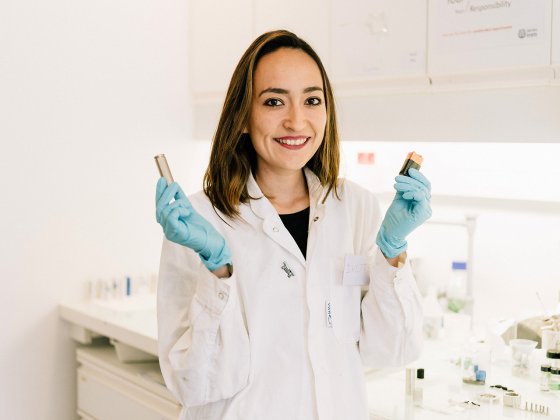
Your research focuses on the development of more efficient batteries for storing electricity, particularly carbon-free electricity. Have you always been interested in the link between chemistry and ecology ?
Initially, it was just a chemistry-related hobby. My interest in ecological issues emerged later. At the end of my Master's degree, I became interested in energy storage. Through lectures in electrochemistry, I discovered how batteries work and their role in society, which prompted me to deepen my knowledge in this field.
We are increasingly interested in developing renewable energies to reduce our dependence on carbon-based energy. However, these energies are often intermittent, due to a lack of wind for wind turbines or a lack of sunlight for photovoltaic panels. It is therefore necessary to find a way of storing large quantities of electricity to compensate for these periods when production is lower than demand, and releasing it when necessary. This is where I realized the potential impact of my research into aqueous batteries, as there is currently no effective, affordable solution for large-scale electricity storage. So I began exploring different battery technologies and came into contact with Prof. Jean-Marie Tarascon. He suggested I do a thesis on zinc-manganese batteries, which was particularly interesting because it offered the chance to work on an innovative topic.
Was it these practical ecological issues that encouraged you to set up a start-up ? Is it important for you not to limit yourself strictly to the academic world ?
It's important to me that there's a practical application. I didn't want to leave the idea up in the air. I was confident enough in my results to say that we could potentially create a practical system. When I went back to work on a contract after my thesis, I wanted to see if it was possible to find a way of creating a start-up. In the end, that's what motivated me. We sometimes do a lot of research without knowing how to apply it to society. It's great to be able to imagine practical applications.
Could you imagine giving up research to devote yourself to these industrial issues ?
No, I don't think I'm cut out for that. It's not my dream. As the founder of a start-up, I'd have to choose between taking charge of the business strategy or continuing in the R&D department. Marketing jobs are very different from being a researcher and, in my opinion, require business skills that I don't have. As a result, I prefer to devote my attention to innovation and research, and that fulfils me completely. As young graduates, we are fortunate to be supported and accompanied in the industrial development of our doctoral research. What's more, the political climate in France is particularly favorable to the creation of start-ups. That's why I decided to seize the opportunity.
What you call your " hobby " linked to chemistry, how did it come about ?
I think it came to me on the bench. It was there, doing experiments, that I realized that research was what I wanted to do. I had a professor in my first year of undergraduate studies who did an extraordinary job of getting students interested in chemistry. He suggested carrying out simple experiments : for example, inducing color changes in liquids by mixing two solutions together, or observing changes in the state of matter. It was quite pretty and elegant to see. For me, there's an aesthetic pleasure that perhaps comes from that.
Did you already have an interest in battery chemistry at that time ?
My interest in battery chemistry came later, around the second year of my Master's degree. I had taken a rather general chemistry course. It was during my Master's internship on zinc insertion batteries that I was convinced to get involved in this field. I wanted to understand how different battery technologies work, because we use them every day without questioning how they work.
During the course of my internship, I explored the scientific literature on zinc batteries, and was struck by the enthusiasm behind the research. They were often presented as the batteries of the future. At the same time, I became aware of all the scientific challenges that had to be overcome to make these systems practical, and I found this very stimulating. I wanted to find out more about this new generation of batteries, which promised to be more environmentally friendly.

Is it possible to imagine greener batteries ?
There are several battery technologies, depending on the metals used. Lithium-ion batteries are currently the most efficient. Lithium is a very light metal, which translates into lightweight batteries. This is why this technology is preferred for portable devices such as cell phones and computers. However, these batteries remain expensive due to two major factors. Firstly, they use rare materials, and in addition to the problems associated with their abundance, there are also concerns about their uneven distribution in the earth's crust, which creates geopolitical problems. Secondly, the manufacture of these batteries imposes very restrictive conditions on companies, as the assembly of these systems must be carried out away from oxygen and water, to avoid any risk of fire.
Aqueous zinc batteries, on the other hand, have no such problems. Zinc is a more abundant metal, more evenly distributed in the earth's crust. What's more, it is stable in the open air and more easily recyclable. However, it makes batteries heavier and less efficient, even if they are cheaper to produce.
So we're unlikely to see them in our phones ?
No, our aim is not to replace lithium-ion batteries, which are the best option for electronic devices. Rather, our vision is for large-scale energy storage, for which there is currently no solution. This is where zinc batteries come into their own. Despite their intrinsic limitations, which make them unsuitable for portable electronic devices, they are proving their worth in the context of battery parks. Imagine sheds as big as a soccer pitch, or even bigger, that could hold several hundred batteries. What's more, it's an old technology that we've mastered well, since it's based on the batteries we already use, but which we need to improve thanks to the latest advances in current research.
How did you come up with the idea of going back to an old technology and trying to improve it ?
It's a technology that's about two hundred years old that we haven't managed to make rechargeable. This is the technology behind the alkaline batteries we all know ! However, we also remember the mediocre performance of the rechargeable batteries on the market at the time, precisely because the technology wasn't suited to it. Electrochemistry was discovered thanks to zinc, and we shouldn't forget that the prototype battery was also made of zinc, but was later abandoned because of the advantages of lithium. Since 2010, there has been renewed interest in zinc batteries, in the hope of optimizing their recharging thanks to our current knowledge. What's more, because we have decades of experience with alkaline batteries, we could more easily develop rechargeable zinc batteries. Last but not least, they are easy to recycle.
What avenues for improvement are you exploring ?
A battery is always made up of three parts : the two electrodes, the anode and the cathode, and the electrolyte, which is the liquid in which they are immersed. These are the components we can influence. First of all, we're looking to reformulate the liquid (the electrolyte), to reduce parasitic reactions and make the system safer and more powerful. We are looking for non-toxic, economical compositions that can be easily mixed in water. For the electrodes, in particular the zinc anode, we test different alloys to avoid the formation of dendrites. When zinc is deposited on the electrode, it tends to form fractal structures resembling tree branches. These grow over the course of charge/discharge cycles and eventually break off, depleting our zinc system and reducing battery performance. As for the cathode, we're working on improving the electronic conduction of manganese oxide. It is therefore necessary to understand all the components of the battery to obtain an optimal battery.
When can we expect to see these innovations deployed ?
Research time is not the same as industry time. We plan to develop a prototype battery for the consumer market within the next two years. This battery could be marketed as a small electric station. However, when it comes to large-scale energy storage, we're talking about a timeframe of ten to fifteen years.
What do you think of the social impact of science and research, particularly in Mexico, your home country ?
There are many environmental problems in Mexico, and these are very visible on a daily basis. Unfortunately, as individuals, there is often little we can do about them, and we often feel powerless. So it's more satisfying to carry out applied research in France. Even though there wasn't much discussion about it during my studies, I soon felt that I could make a contribution to society in terms of the environment. What's more, I've noticed that new generations are increasingly aware of the impact of global warming. So I'm hopeful that society will make great strides in this area. In any case, I hope to make my contribution to this transition.
Ivette Aguilar is a researcher at the Collège de France's Chemistry of Materials and Energy Laboratory, under the supervision of Prof. Jean-Marie Tarascon.
Photos © Patrick Imbert
Interview by Aurèle Méthivier








